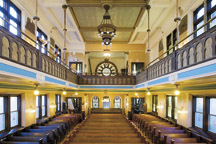It took 10 years for the first congregants of Hoboken’s Star of Israel synagogue to complete the building in the early 1900s, but just one year for the current members to finish major upgrades.
The historic temple at 115 Park Ave. is currently used by the United Synagogue of Hoboken. President Ken Schept said more improvements will follow, assuming fundraising continues to fund renovations.
Phase I was just finished, Schept said, and the congregation was able to address the most pressing need: safety. They collected $1.1 million in donations and received a grant to fund the large project.
“It’s a gift from the present to future generations.” – Robert Sheinberg
________
Jewish community revival
When the synagogue was built, Schept said there were several Jewish congregations in town, but membership dwindled in the 1950s. Around 1971, two remaining congregations joined together to form the United Synagogue of Hoboken, whose members occupy the Star of Israel temple today.
Before a 1989 Jewish revival in Hoboken, Schept said the synagogue was only used for special occasions. The main place of worship was in the Jewish Community Center, 830 Hudson St. That building has since been turned into condos, and contents were moved downtown.
The revival brought along changes to the congregation, like a full-time rabbi, and stress on the old building from an increased population.
Star of Israel was soon expanded to include an administration building next door that houses a pre-school and learning center.
Safety first priority
Schept said congregants told a consultant hired by the synagogue that they had three priorities: safety, comfort, and beautification.
Members were uncomfortable without air conditioning in the hot summer months and were tired of their shirts being stained by old lacquer on the pews.
Air conditioning may be coming in the next phase, but safety took priority in the first round.
“The old wire had paper insulation,” Schept said. Outmoded wiring among other things were corrected in this round of restoration.
They contracted MLB Construction and Management of Hoboken, led by Harold Berlowe, to undertake the repairs.
“Everything was just falling apart,” Berlowe said as he pointed out the various improvements his team was trying to complete before the upcoming holiday. “The stairs wobbled,” he said. “I thought to myself, ‘How is this balcony still standing up?’ ”
The congregation has been suffering through a rehab process that included an overhead draping from the balcony that hid ongoing work.
Schept hopes that the 300 or so worshipers that come through for the holiday will enjoy just being able to see the ceiling at this point.
“The most challenging thing was just trying to keep this place operational while we had construction going on all three floors,” Schept said.
At one point in the process, hammer-drilling interrupted a brit millah, a circumcision ceremony that requires precision and concentration, on the next floor.
“We ran up there and yelled, ‘Stop!’ [to the workers],” Berlowe said, chuckling with the hindsight that all ended well.
New roof and a clean-up
The synagogue was accepted to the state and national Register of Historic Places in 2008, which made the building eligible for historic grants.
Schept said they subsequently received a $280,000 grant that the congregation matched with their own funds.
With the grant money, they were limited to exterior upgrades, some of which were cosmetic.
“The fact that we received the grant reshaped the job,” Schept said. It allowed the synagogue to supplement the safety and infrastructure upgrades with some aesthetic rehabbing. But the grant wasn’t all spent on beautification; they also replaced the roof.
They re-pointed the brick exterior, weather-sealed and restored the “onion domes” that adorn the temple, and gave the almost-ancient building a much needed cleaning.
“I never realized [the exterior] was so dirty,” Schept said. “This pretty much what the building looked like [in 1915].”
Focus on Phase II
Schept said the group can complete the rehabilitation in one more phase, if fundraising can continue to support the project. Otherwise, the next phase will be scaled back to match money available and a third round of improvements will become optional should the money becomes available in the future.
“We can do it in one more push,” he said, encouraging constituents to reach deep into the pockets for contributions.
Their investment is tangible. “I can say, ‘Just look up,’ ” he said, motioning to the new roof. “That’s what the rest of this place can look like.”
He also commended scores of congregants who contributed their expertise in different ways, from designing stained glass windows to wiring a new sound system.
Berlowe, himself a congregant, added, “Just about anybody with some sort of talent has contributed in some way.”
Rabbi Robert Scheinberg said the plaque on the wall naming the individuals who built the place of worship in 1905 can serve as a reminder to those considering a donation.
“When a community embarks on this kind of project, it’s a gift from the present to future generations,” he said. “[We are] beneficiaries of that gift from previous generations.”
Timothy J. Carroll may be reached at tcarroll@hudsonreporter.com.
